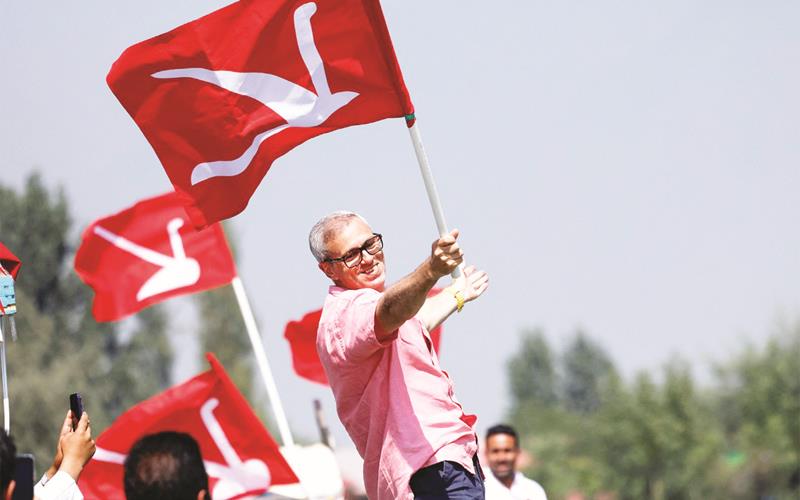How, like 1977, NC swept the elections in Kashmir
Ahmed Ali Fayyaz. Updated: 10/13/2024 12:55:01 AM
Front Page

Srinagar: For many, the Assembly elections of 2024 in Jammu and Kashmir were “a 1977 moment”.
In 1977, Assembly elections were conducted in Jammu and Kashmir in three months of the Janata Party (JP) alliance assuming power at the Centre. A day after the declaration of the results which saw Morarji Desai becoming India’s first non-Congress Prime Minister, the Congress party withdrew support from Sheikh Mohammad Abdullah’s government in Jammu and Kashmir.
On Chief Minister Sheikh Mohammad Abdullah’s advice, the Legislative Assembly was dissolved and fresh Assembly elections were held in June 1977 in the Governor’s rule. For the House of 76 seats, Sheikh’s National Conference (NC) won 47 seats—39 in Kashmir, 1 in Ladakh and 6 in Jammu. Congress won a total of 11 and JP 13 seats. Jamaat-e-Islami got the one-odd seat of Sopore.
NC’s victory was spectacular in the Valley. Of the 42 seats, it swept 39. Two went to JP and only one to JeI. It also won 6 seats in Jammu’s Muslim majority areas.
Notwithstanding the fact that a number of top-notch politicians and regional parties formed a grand alliance with the JP to defeat the NC, the results were surprising. JP got 11 seats in Jammu and only two (Handwara and Eidgah) in Kashmir.
The polarisation on regional and religious lines was evident. While the Hindu vote in Jammu went to JP and Congress, the Muslim vote went en masse to the NC.
Forty-seven years later, an identical polarisation happened in Jammu and Kashmir, albeit with the difference that the Hindu vote was split between the BJP and Congress. In the Valley of 47 segments, the NC-Congress alliance bagged 42. NC alone won 35 besides a rebel in Shopian. The alliance left out only 6 seats out of 47 in Kashmir.
Unlike in 1977, a number of candidates contested as ‘independents’ but they were widely perceived to be the Union Government’s proxies in camouflage. With every passing day of the campaign, most of the people in Kashmir began viewing these ‘independents’ as the candidates sponsored by New Delhi only to defeat the NC and the PDP.
While the senior BJP leaders, including Prime Minister Narendra Modi and Home Minister Amit Shah, kept asking the Kashmiris to vote for “anybody other than NC, PDP and Congress”, BJP’s incharge of the Assembly elections Ram Madhav asserted that his party wanted a “Jammu centric government” in J&K this time. A number of such rhetorical statements and divisive assertions polarised the voters on regional and religious lines.
Under Newton’s Third Law of Motion, most of the Kashmiris and Muslims in Jammu’s Chenab and Pir Panjal regions rallied behind the NC.
Besides, over a dozen of the candidates of the separatist background jumped into the fray as ‘independent candidates’. The detained Baramulla MP, Engineer Rashid, who has been under incarceration for terror funding since 2019, was released and permitted to field around 40 of his candidates in different segments.
The face of the 2019 Burhan Wani turmoil, Sarjan Barkati was also released on bail and permitted to carry out his campaign. He contested against NC’s Chief Ministerial candidate Omar Abdullah in Ganderbal. On the other hand, Engineer Rashid fielded a former functionary of Kashmir Chamber of Commerce and Industry, Sheikh Ashiq, to ‘defeat’ Omar in Ganderbal. Rashid claimed that he would have won 50 seats—all 47 in Kashmir and three more in Jammu if he had been released a month earlier.
People at large doubted their credentials as they individually and collectively mounted their attacks selectively on the NC. Upon this development, the Kashmiris decided to vote “against New Delhi”.
When the votes were counted on 8 October, Omar was found to have polled 32,727 votes. He defeated his PDP rival Bashir Ahmad Mir with a margin of 10574 votes. All others forfeited their security deposits. They included AIP’s Sheikh Ashiq who stood at Number 7 with just 963 votes. Barkati stood at Number 12 with just 438 votes.
In Budgam, Omar defeated senior Hurriyat leader Aga Syed Hassan’s son Aga Syed Muntazir Mehdi with a massive margin of 18,485 votes.
In Chrar-e-Sharief, Peoples Democratic Front founder and former Minister Hakeem Mohammad Yasin attempted to defeat NC’s stalwart Abdul Rahim Rather. After 1990, Hakeem has lost only once in his home segment of Khansahab. Rather has won as many as 6 elections from Charar-e-Sharif. Hakeem’s real move to fight from Charar-e-Sharif, in addition to Khansahab, seemed to be an attempt to cut away a chunk of the NC’s traditional votes. It would have helped PDP’s Ghulam Nabi Lone Hanjura to score his second victory after 2014.
However, Hakeem lost in both the segments. He polled a total of 4,401 votes against Rather’s 35,957 votes.
All other ‘independent candidates’, including the Parliament attack convict Afzal Guru’s brother and all but two candidates of Jamaat-e-Islami background lost their security deposits. They included a former Mayor of Srinagar Municipal Corporation and a number of former councillors.
Across the valley, the JeI-supported candidates got substantial votes in only Kulgam and Pulwama. Still they failed to defeat CPM stalwart Mohammad Yousuf Tarigami and PDP’s Waheed-ur-Rehman Para.
Even in Zainapora, a JeI stronghold which returned PDP’s Mehbooba Mufti in 2008, the JeI-backed candidate and PDP rebel Aijaz Mir lost to NC’s Showkat Hussain Ganai with a humongous margin of 23,233 votes.
Even as Engineer Rashid’s brother won with a thin margin of 1,602 votes in his home segment of Langate. Most of his more than 40 candidates lost their security deposits, Interestingly, Engineer Rashid had taken lead in as many as 14 of the 18 Assembly segments in North Kashmir. This time, he had to be content with one.
Updated On 10/13/2024 12:56:53 AM